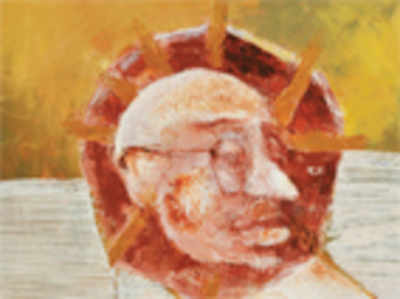Truth of a different era

After 80, great masters don’t retire. They reign.
Arranged by the Time and Space gallery to commemorate Martyrs’s Day (Jan 30), the show, says Renu George, founder of the gallery, “is like viewing the life of Gandhi.Haku bhai has captured the simplicity and the spirit and intellect of an enlightened man.”
That Haku Shah himself is a Gandhian makes the association apt. Shah was born in a small tribal village, Valod, in Gujarat and taught for a period at a Gandhian Ashram, Vedechhi (South Gujarat). “For my father, Gandhism has been a way of life,” Parthiv Shah notes. “My brother and I have seen him live a simple life, aspire for little materialism and partake in work that may otherwise be labelled as menial.
So, (it’s no surprise that) his works are about Gandhi who was his inspiration. There is no tokenism on the life of the Mahatma. No picking up of the broom and cleaning just for the sake of it.”
Unlike other artists of his time whose interactions with art happened within their studios, Shah had interactions at multiple levels of art.
He established a tribal museum in Gujarat, something unheard of in the high-brow circle of art. At the same time, he helped set up the avant-garde National Institute of Design, Ahmedabad where he taught from 1961-1967. In the early sixties, he made tribal art of India fashionable in the US when he curated a pioneering exhibition Unknown India (1961) that had patachitra, kalamkari paintings and more.
Artist Yusuf Arakkal, who defines Shah as one of India’s more respected artists, says that Shah himself never aspired for any tags. “His works are straightforward and minus the trappings of show,” he says. Prathiv elaborates that his father was never flamboyant, never called a journalist or anyone and said —‘Let’s meet over a drink’. “He never drank or cared for the limelight. Over the years, he has been able to achieve more with lesser things.”
The paintings of Nitya Gandhi have all the symbols the Mahatma has always been associated with — the broom, the charkha, the cotton spindle, the three monkeys, the salt march, the search for satya (truth) and ahimsa (nonviolence). His style has been compared with that of German-Danish artist Emile Nolde by S Kalidasa, contemporary art historian. “The line portrait of Gandhiji spinning the charkha in monochrome is so fluid as to seem alive with movement,” he writes about the work.
But do the works find any synergy with the present generations? “That is a challenge,” Parthiv says. “How do you first get them into the gallery to see this show? His language is different from what is spoken today on social media sites. Art has become mass produced and industrial.”
Kalidasa feels that today, more than at any time, Gandhi represents the alternative. “Haku Shah knows that truth and paints it with disarming humility and deep conviction.”
And he paints everyday even now, Parthiv informs happily, even if they are just a few strokes. Shah’s favourite occupation now is to sit on the swing at home and gently rock himself. As he reigns with masterly ease, his belief ‘Each and every moment of Gandhiji was creative’ has been distilled into the canvases.
Nitya Gandhi, 10 am to 5 pm, Jan 4 – 21, NGMA.
Go For It... Jayanthi Says So
TIMELESS portraits
The works of a Russian master and his son have found the unlikeliest home in the city. Nicholas (1874-1947) and Svetoslav Roerich (1904-1993) have a large body of works between them; the senior having painted over 1,000 works in his lifetime. Nicholas Roerich is still celebrated as an artist in his native Russia. He was also a philosopher, archeologist and writer and lived in Kulu Valley till the end of his life. His son married actress Devika Rani and lived in Bengaluru. Well-known for his portraits and the use of earthen tempera colours that he personally mixed with natural bindings, he assured students, notably Dr MJ Kamalakshi, who would watch him paint at his studio in Tataguni estate that his works would never fade. Time has proved him right. Chitrakala Parishath, Museum Gallery
ART OF MANY SEASONS
Artist Milind Nayak calls his solo show a “fresh infusion of life” in the new year. After having undergone setbacks in his health earlier, he was recently delighted with a considerable degree of recovery. He is known for his oil and soft pastel works as well as watercolours. The three galleries of the Rangoli-Metro Art Centre will see 120 of his works that have been divided into watercolours, oils and pastels. There are works spanning a 15-year-period (1999-2014) and will best define his evolving oeuvre. From the bright colourful endeavours to dark abstracts — the works span gentle water to the rough turbulent seas. A delightful show to see and study. Fragments from an Unstructured Existence, 11 am – 7.30 pm, Rangoli-Metro Art Centre
GALLERIES View more photos





















